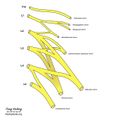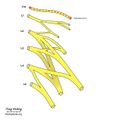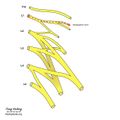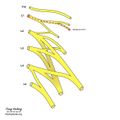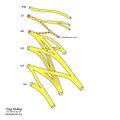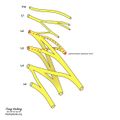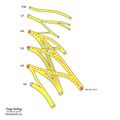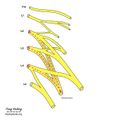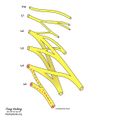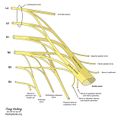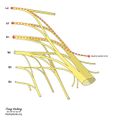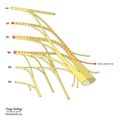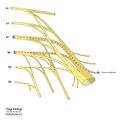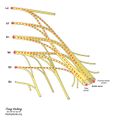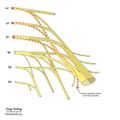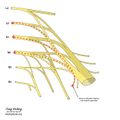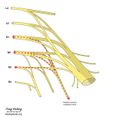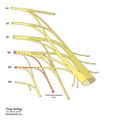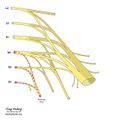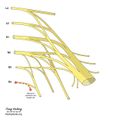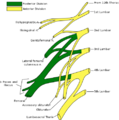◒
Lumbosacral Plexus: Difference between revisions
From WikiMSK
No edit summary |
No edit summary |
||
| Line 21: | Line 21: | ||
| Femoral nerve ||L2, L3, L4 anterior rami, posterior divisions || Quadriceps femoris, sartorius, pectineus, iliacus || Knee extension || Medial lower leg (through saphenous nerve | | Femoral nerve ||L2, L3, L4 anterior rami, posterior divisions || Quadriceps femoris, sartorius, pectineus, iliacus || Knee extension || Medial lower leg (through saphenous nerve | ||
|- | |- | ||
| Lumbosacral trunk / furcal nerve || L4-5, mainly L5 || Ankle dorsiflexion, eversion, inversion || || L5 sensory loss | | Lumbosacral trunk / [[Furcal Nerve|furcal nerve]] || L4-5, mainly L5 || Ankle dorsiflexion, eversion, inversion || || L5 sensory loss | ||
|} | |} | ||
| Line 63: | Line 63: | ||
Lumbar Plexus.png|Lumbar Plexus | Lumbar Plexus.png|Lumbar Plexus | ||
</gallery> | </gallery> | ||
[[Category:Lumbar Spine Anatomy]] | [[Category:Lumbar Spine Anatomy]] | ||
[[Category:Nerves of the Lower Limb and Lower Torso]] | [[Category:Nerves of the Lower Limb and Lower Torso]] | ||
[[Category:Partially complete articles]] | [[Category:Partially complete articles]] | ||
Revision as of 15:35, 26 April 2021
This article is still missing information.
The lumbosacral plexus can be divided into two anatomical parts: the upper lumbar plexus and the lower lumbosacral plexus.
Lumbar Plexus
The lumbar plexus is located within the psoas muscle. It contains the canterior rami of the T12 to L4 nerve roots. Only the femoral nerve can be reliably tested by EMG. The lateral femoral cutaneous nerve can be tested but it is unreliable.
| Nerve | Segment | Motor Supply | Action | Sensory Supply |
|---|---|---|---|---|
| Iliohypogastric nerve | T12/L1 | Transverse and internal oblique muscles | N/A | Lower abdomen |
| Ilioinguinal nerve | L1 | Inferior abdominal muscles | N/A | Inguinal region, small area of media thigh, and upper scrotum/labia |
| Genitofemoral nerve | L1, L2 | Cremasteric muscle in men | N/A | Skin of femoral triangle. Lower scrotum/labia |
| Lateral femoral cutaneous nerve | L2,L3 | N/A | N/A | Lateral thigh |
| Obturator nerve | L2, L3, L4 anterior rami | Adductor magnus (anterior half), adductor longus, adductor brevis, gracilis, obturator externus | Hip adduction | Medial thigh |
| Femoral nerve | L2, L3, L4 anterior rami, posterior divisions | Quadriceps femoris, sartorius, pectineus, iliacus | Knee extension | Medial lower leg (through saphenous nerve |
| Lumbosacral trunk / furcal nerve | L4-5, mainly L5 | Ankle dorsiflexion, eversion, inversion | L5 sensory loss |
Sacral Plexus
| Nerve | Segment | Motor Supply | Action | Sensory Supply |
|---|---|---|---|---|
| Superior gluteal | L4-S1 | Gluteus medius, gluteus minimus, tensor fasciae latae | hip abduction | buttock pain |
| Inferior gluteal | L5-S2 | Gluteus maximus | hip external rotation and power extension | N/A |
| Sciatic trunk/nerve | L5–S3 | Posterior thigh muscles (except biceps femoris short head), and leg through common peroneal and tibial nerves | - | |
| Pudendal nerve | S2-4 | - | - |
Sacral Plexus Images
Other Branches
| Nerve | Segment | Motor Supply | Action | Sensory Supply |
|---|---|---|---|---|
| Tibial | L4-S3 | Hamstrings (except short head of biceps femoris, posterior part of adductor magnus), triceps surae, tibialis posterior, popliteus, flexor digitorum longus, flexor hallucis longus, intrinsic muscles of foot | Knee flexion(primary), foot plantar flexion, toe flexion | skin of posterior leg and sole of foot |
| Common fibular | L4-S2 | short head of biceps femoris, fibularis longus and brevis, tibialis anterior, extensor hallucis | knee flexion (short head of biceps femoris), foot dorsiflexion and eversion, toe extension | skin of anterior and lateral leg and dorsum of foot |
Videos
